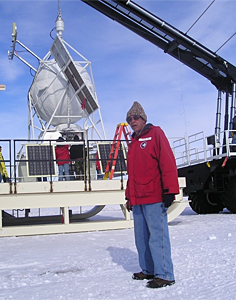John P. Wefel
Professor Emeritus of Physics
Director Emeritus, Louisiana Space Consortium
Ph.D., 1971 - Washington University-St. Louis
Louisiana State University
Department of Physics & Astronomy
Space Science/Particle Astrophysics
Fellow of the American Physics Society
Research Interests
Astrophysics - Experimental/Theoretical
Our High Energy Astrophysics research attempts to understand the nature and origin of energetic charged particles through measurements of galactic cosmic radiation (GCR) and solar energetic particles (SEP), and their access into our Geospace environment. The GCR represent the only sample of matter from outside our solar system available for direct study, and comparing their composition to the sun, meteorites, stars, solar flares, and the interstellar medium provides insight into the origin of this matter. Since particle transport is controlled by electromagnetic effects, and subject to nuclear interactions, we also conduct experiments at accelerators. Currently, we are finishing the balloon campaign for ATIC -- (Advanced Thin Ionization Calorimeter), which measured the GCR composition and energy spectra up to 100 TeV, flying from McMurdo, Antarctica, and circumnavigating the continent. ATIC had three successful flights and final data analysis is underway. The group worked on the (non-selected)ACCESS project, a combination calorimeter/transition radiation detector for the Space Station and is currently working with an international team on CALET (CALorimetric Electron Telescope). CALET was launched in 2015 by the Japanese HTV system and placed upon the Exposed Facility of the Japanese Kibo module on the International Space Station. CALET continues to return excellent data. Wefel was also the statewide director for LaSPACE, the NASA Space Grant Program for Louisiana, and for NASA EPSCoR. In addition, he is director emeritus of the International School of Cosmic Ray Astrophysics.
Current and Select Publications
“Charge-Sign Dependent Cosmic-Ray Modulation Observed with the Calorimetric Electron Telescope on the International Space Station,” O. Adriani et al. (CALET Collaboration), Phys. Rev. Lett. 130, 211001 (2023); Erratum: Phys. Rev. Lett. 131, 109902 (2023)
“Cosmic-ray Boron Flux Measured from 8.4 GeV/n to 3.8 TeV/n with the Calorimetric Electron Telescope on the International Space Station,” O. Adriani et al. (CALET Collaboration), Phys. Rev. Lett. 129, 251103 (2022)
“Observation of Spectral Structures in the Flux of Cosmic-Ray Protons from 50 GeV to 60 TeV with the Calorimetric Electron Telescope on the International Space Station,” O. Adriani et al. (CALET Collaboration), Phys. Rev. Lett. 129, 101102 (2022)
“CALET Search for Electromagnetic Counterparts of Gravitational Waves during the LIGO/Virgo O3 Run,” O. Adriani et al. (CALET Collaboration), Astrophysical Journal, 933, 85 (2022)
“An excess of cosmic ray electrons at energies of 300-800 GeV,” J. Chang et al. (The ATIC Collaboration), Nature 456, 362-365 (2008)
“Astrophysics at Ultra-high Energies,” eds. M. M. Shapiro, T. Stanev and J. P. Wefel, Science and Culture Series -- Astrophysics (Singapore, 2007, World Scientific), 226 p